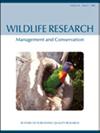新西兰南岛入侵班尼特小袋鼠的空间生态
IF 1.6
3区 生物学
Q3 ECOLOGY
引用次数: 0
摘要
本文章由计算机程序翻译,如有差异,请以英文原文为准。
Spatial ecology of invasive Bennett’s wallaby in South Island, New Zealand
ABSTRACT Context. Bennett’s wallaby (Notamacropus rufogriseus) was introduced into New Zealand in the late-1800s, and has subsequently become a significant pest to agriculture, silviculture, and native vegetation. Effective management of wallabies requires robust spatial and temporal ecological information, which can be used operationally to increase detection and kill rates. Aims. To determine home range size and shape, resource (i.e. habitat and topography) selection, and daily movement patterns of three populations of Bennett’s wallaby in the South Island. Methods. We attached GPS-collars to 38 adult wallabies (17 females, 21 males) between May 2018 and May 2019, and obtained usable location data from 30 individuals. We used kernel density estimators and resource selection functions to quantify seasonal home ranges and resource selection, respectively. Key results. The mean seasonal home range sizes of males and females were similar (26.8 ha and 24.8 ha, respectively; combined range = 1.2–101.9 ha), although the largest home ranges belonged to large males. Resource selection was strongly influenced by distance to concealment cover, ridgelines and streams, i.e. wallabies selected to be closer to these features, though not necessarily at them. Wallabies selected areas close to concealment cover throughout 24-h periods, but most strongly during the day, which is when they bed in dense cover. Wallabies sampled outside of peak breeding moved most during dusk and dawn (median = ~50 m/h), whereas those sampled during peak breeding moved widely during day, dusk, and night (110–280 m/h), but not dawn (median = ~50 m/h). Conclusions. The home range sizes of wallabies in New Zealand were highly variable, but on average were similar for males and females. Wallabies selected pasture close to areas with some cover, suggesting a trade-off between access to high-quality forage and concealment cover. Implications. Our results provide robust data for modelling management strategies for wallabies, and contribute directly to operational planning by identifying habitats where wallabies are most likely to be found temporally. This information can be used to determine the appropriate survey methods and control tools to maximise detection rates and kill rates of wallabies, based on habitat.
求助全文
通过发布文献求助,成功后即可免费获取论文全文。
去求助
来源期刊

Wildlife Research
生物-动物学
CiteScore
4.30
自引率
15.80%
发文量
56
审稿时长
3 months
期刊介绍:
Wildlife Research represents an international forum for the publication of research and debate on the ecology, management and conservation of wild animals in natural and modified habitats. The journal combines basic research in wildlife ecology with advances in science-based management practice. Subject areas include: applied ecology; conservation biology; ecosystem management; management of over-abundant, pest and invasive species; global change and wildlife management; diseases and their impacts on wildlife populations; human dimensions of management and conservation; assessing management outcomes; and the implications of wildlife research for policy development. Readers can expect a range of papers covering well-structured field studies, manipulative experiments, and analytical and modelling studies. All articles aim to improve the practice of wildlife management and contribute conceptual advances to our knowledge and understanding of wildlife ecology.
Wildlife Research is a vital resource for wildlife scientists, students and managers, applied ecologists, conservation biologists, environmental consultants and NGOs and government policy advisors.
Wildlife Research is published with the endorsement of the Commonwealth Scientific and Industrial Research Organisation (CSIRO) and the Australian Academy of Science.
 求助内容:
求助内容: 应助结果提醒方式:
应助结果提醒方式:


